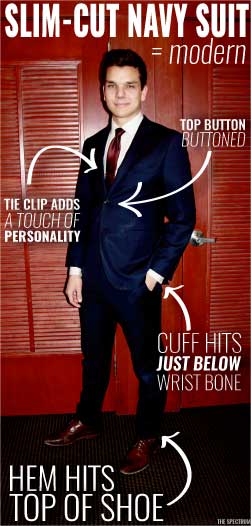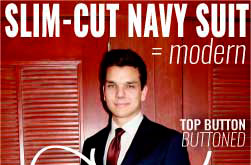
When you’re meeting a prospective employer, going to an interview or starting your professional career, what you wear plays a big part in both how you are perceived and how you feel. With the Career Expo coming Tuesday and Wednesday, it’s a good time to master the art of career dressing.
Let’s start with a common area of confusion: the difference between business casual and business professional. Business casual is actually more “business” than “casual.” That means wearing khakis or slacks, a dress shirt, loafers and an optional tie. Business professional (also called business formal) dress calls for a suit, dress shirt and tie. You can adhere to either one of these dress codes for the career expo, but for an interview, you should dress in your business professional best.
When it comes to suits, fit and styling can make or break your look. Wearing a suit too big is one of the most common mistakes men make. Even if you buy a suit that fits fairly well, you still might need to take it to a tailor to get it altered so that it fits you perfectly in all places. The shoulder seam of the jacket should line up with the edge of your shoulder. If you’re unsure of exactly where that is, lift your arm up to the side and find the slight dip that forms at the shoulder edge.
Sleeve cuffs should hit right where your palm starts when your arms are hanging at your sides. Make sure the collar and cuffs of the dress shirt peek out from the jacket a bit; a half inch for cuffs and a half to 1 inch for the collar is a general guideline, but it varies depending on the style of shirt. Button only the top button on your suit jacket, but unbutton it whenever you sit down. When buttoned, the jacket should fit but not be so tight that it strains, pulling at the buttons and fabric. The tip of the tie should end somewhere between the top and middle of your belt buckle.
Where the hem of your pants hits depends on the style of suit you choose. Traditionally, the back of the hem should touch the top of the sole of your shoe and have a slight break in the front. With contemporary slim fit suits, the hem looks best if it skims the top of the shoe by your ankle. In general, if the hem falls between the top of the shoe and top of the sole, you should be safe.
The Halberstadt’s sales associates recommend wearing a navy blue or charcoal gray suit to an interview because black can look a bit overkill unless the interview is at a very serious and traditional company. Under your suit, wear a solid white shirt and a colored tie in a subtle print. For shoes, choose polished lace up oxfords instead of loafers, which can look too casual, and always match them to your belt.
North Dakota State Career Center director Jill Wilkey agrees with Halberstadt’s recommendation of staying away from bright or flashy shirts and ties for an interview.
“You don’t want a signature statement to precede you,” she says.
Wilkey also advises students who don’t want to invest in a suit or other professional attire for an interview or career fair to utilize the Career Center’s Career Closet. Just call or stop in to make an appointment, and they will lend you everything you need for free.
Following professional dress rules is important, but adding your own style to an outfit can set you apart from other job candidates and show an interviewer who you are.
“You need to understand the industry you’re interviewing with,” Wilkey says. For certain companies, you should be conservative when interviewing, but in more creative fields, they are expecting you to show your individuality.
“Show personality through the details,” says Gavin Doppler, a sales associate at Halberstadt’s. “That can make the difference between getting that call back or not.”
You can add those details via a pocket square, lapel pin, tie clip, watch or cufflinks. Another fun way to add a touch of style to your outfit is sporting a pair of patterned socks. Traditionally, your socks should match the color of your pants, but you can coordinate them with the colors in your shirt and tie for a more creative look. Little touches like that can act as conversation starters that set you apart and get your future employer to remember you.
This is the first installment of a two-part guide to professional dressing. See The Spectrum on Monday for a woman’s career dressing guide.
